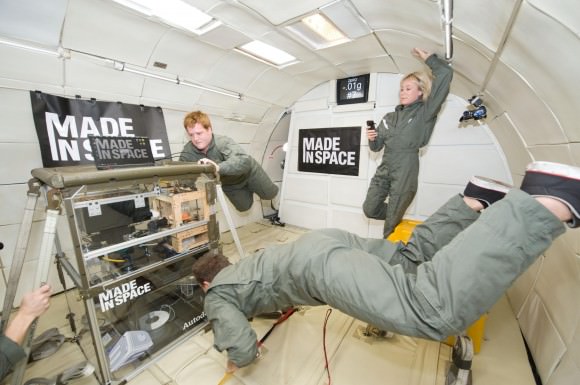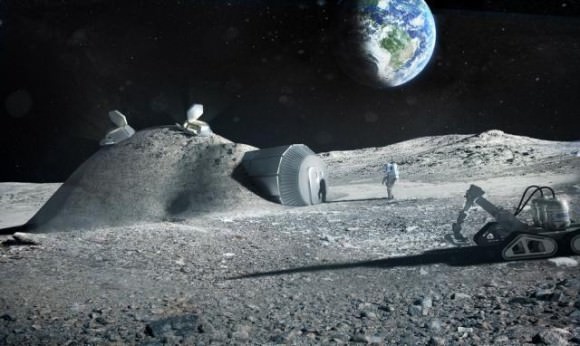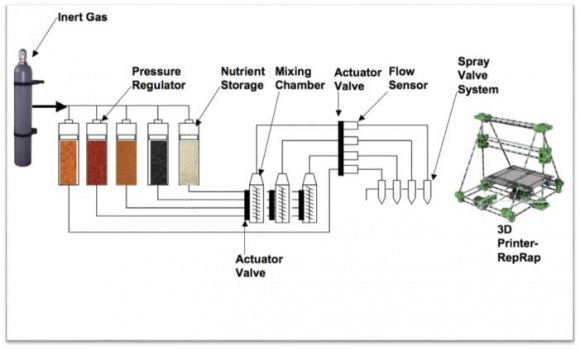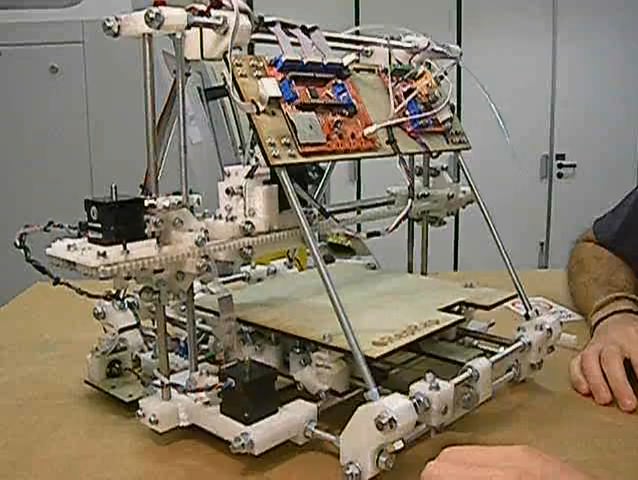The International Space Station may soon have its very own Star Trek food replicator.
Earlier this week, NASA awarded a $125,000 six month grant to the Systems & Materials Research Cooperation to design a 3D printer capable of printing a pizza from 30-year shelf stable foodstuffs.
Founded by Anjan Contractor, SMRC built a basic food printer from a chocolate printer to win NASA’s Small Business Innovation Research Program in a trial video. The design is based on an open-source RepRap 3D printer.
Contractor and SMRC will begin construction on the pizza-printing prototype in two weeks. Pizza has been one item missing from astronauts menu for years. The 3D printer would “build-up” a pizza serving by first layering out the dough onto a heated plate then adding tomato sauce and toppings.
But this isn’t your mother’s pizza, as the proteins would be provided by cartridge injectors filled with organic base powders derived from algae, insects and grass.
Yummy stuff, to be sure!
Of course, one can see an immediate application of 3D food printing technology for long duration space missions. Contractor and SMRC envisions 3D food printing as the wave of the future, with the capacity to solve world hunger for a burgeoning human population.
Could a 3D food printer be coming to a kitchen near you?
Curiously, printing confectioneries and pet food pellets would be the simplest application of said technology. Printing a soufflé and crowned rack of lamb will be tougher. 3D printing technology has made great strides as of late, and RepRap has made a printer which is capable of printing itself. Those who fear the rise of Von Neumann’s self-replicating robots should take note…
Should we welcome or fear our self-replicating, pizza-bearing overlords?
The International Space Station is due for the delivery of its first 3D printer in 2014. This will give astros the capability to fabricate simple parts and tools onsite without requiring machining. Of course, the first question on our minds is: How will a 3D printer function in zero-g? Will one have tomato paste an insect parts flying about? Recent flights aboard a Boeing 727 by Made in Space Inc have been testing 3D printers in micro-gravity environments.

Further afield, 3D replicators may arrive on the Moon or Mars ahead of humans, building a prefab colony with raw materials available for colonists to follow.

Will 3D food replicators pioneered by SMRC be a permanent fixture on crewed long duration space missions? Plans such as Dennis Tito’s Mars 2018 flyby and the one way Mars One proposal will definitely have to address the dietary dilemmas of hungry astronauts. Biosphere 2 demonstrated that animal husbandry will be impractical on long term missions. Future Martian colonists will definitely eat much farther down the food chain to survive. SpaceX head Elon Musk has recently said in a Twitter response to PETA that he won’t be the “Kale Eating Overlord of Mars,” and perhaps “micro-ranching” of insects will be the only viable alternative to filet mignon on the Red Planet. Hey, it beats Soylent Green… and the good news is, you can still brew beer from algae!

Would YOU take a one way journey to Mars? Would you eat a bug to do it? It’ll be interesting to watch these 3D printers in action as they take to space and print America’s favorite delivery fast food. But it’s yet to be seen if home replicators will put Dominos Pizza out of business anytime soon. Perhaps they’ll only be viable if they can print a pizza in less than “30 minutes!”


Maybe they can print some Space Food Sticks.
Hilarious! You must be near my age if you’re referencing Space Food Sticks. I remember them from the 1970’s. Chocolate, peanut butter and vanilla flavor, if I recall correctly. They were one of the byproducts of the Apollo program along with Tang.
I was gonna post about Tang but you wouldn’t need a 3D printer for that. Captain Picard of the Apollo era may have demanded “Tang Earl Grey Hot”.
“Should we welcome or fear our self-replicating, pizza-bearing overlords?” …and this is why UT is my favorite Space science site!
I think this is all a waste of money and very strange that normally very economical NASA pay for its development. It is more efficient to feed of the 30 year nutrient storage as and when needed without having to process the food any further. Why send unprocessed food to outer space when processing of it beyond the most basic in terms of just extending shelf live is an inefficient frivolity?
Asides from plain mixing, heating or cooling why waste time and energy processing food when all that mechanical work can be carried out on Earth saving astronauts the trouble and having to mechanically service an unnecessary machine or its food storage feed? Why does it have to be a pizza lookalke or equally replicate the morphology of some other food item when its not really what it is and to make it so is purely an aesthetically but falsely tangible construct? This is in no way recreating the food replicators on Star Trek where the real thing is fictionally copied to the molecular scale.
If some people can’t cope with the high protein of insects by eating them as they are cooked but without changing their form, then their problem is that they were culturally taught as such as children and only that. NASA and the other jointly space faring organisations ought to look into obtaining their protein from leguminous sprouts anyway. Over 20% content in lentils and more so in soya bean sprouts and all you need to to do is add water and wait for a certain known period. Apart from we already knowing that legumes sprout easily in no gravity I surely empathise astronauts being sent their food treats such as apples from someone’s orchard, an event I read that did actually happen
Nothing special here. It would not matter if “Printed” or squirted in a cup, it’s still proteins and flavors that have to be grown and supplied to this “Printer”. It’s not going to make you a steak out of a few tubes of foodstuff. When this $1000 price point gadget hits the market people will find these cartridges of proteins and nutrients will have the same overprice as your $1 worth of ink in a $40 computer printer cartridge. Won’t fly other than a novelty. It’s been said that this gadget will end world hunger, I guess if you like to eat bugs. If they want to end world hunger how about the government stop paying farmers to not grow food to keep prices up or to stop using land to produce crops for fuel additive. 10% alcohol in gas is like paying for a gallon of milk that’s been cut with 10% water. That 10% in an inert filler that has no nutritional value to the milk other that to take up space in a gallon jug.